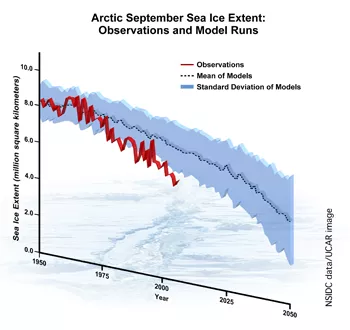Arctic sea ice is melting at a significantly faster rate than projected by the most advanced computer models, a new study concludes (see Figure 1).
Scientists at the National Snow and Ice Data Center (NSIDC) and the National Center for Atmospheric Research (NCAR) found that satellite and other observations show the Arctic ice cover is retreating more rapidly than estimated by any of the eighteen computer models used by the Intergovernmental Panel on Climate Change (IPCC) in preparing its 2007 assessments.
The study, "Arctic Sea Ice Decline: Faster Than Forecast?" will appear tomorrow in the online edition of Geophysical Research Letters (GRL). Julienne Stroeve of NSIDC led the study, with funding from NASA. NCAR’s principal sponsor is the National Science Foundation.
The Arctic is highly sensitive to global warming. However, the study shows that Arctic ice retreat is happening more quickly than any of the IPCC models have indicated. "This suggests that current model projections may in fact provide a conservative estimate of future Arctic change, and that the summer Arctic sea ice may disappear considerably earlier than IPCC projections," said Stroeve.
The study compared model simulations of late twentieth-century climate with observations. "This technique gives some indication of the realism of the simulated sea ice sensitivity to climate changes," said NCAR scientist Marika Holland, a co-author of the study.
When the authors analyzed the IPCC computer model runs, they found that, on average, the models simulated a loss in September ice cover of 2.5 percent per decade from 1953 to 2006. The fastest rate of September retreat in any individual model simulation was 5.4 percent per decade. September marks the yearly minimum of sea ice in the Arctic. But newly available data sets, blending early aircraft and ship reports with more recent satellite measurements, show that the September ice actually declined at a rate of about 7.8 percent per decade during the 1953 to 2006 period.
"Because of this disparity, the shrinking of summertime ice is about thirty years ahead of the climate model projections," said NSIDC scientist and co-author Ted Scambos. This suggests that the Arctic could be seasonally free of sea ice earlier than the IPCC projected range of 2050 to well beyond 2100.
The authors speculate that the computer models may fail to capture the full impact of increased carbon dioxide and other greenhouse gases in the atmosphere. Whereas the models indicate that about half of the ice loss from 1979 to 2006 was caused by increased greenhouse gases, and the other was half caused by natural variations in the climate system, the GRL study indicates that greenhouse gases may be playing a significantly higher role.
There are a number of factors that may lead to the low rates of simulated sea ice loss. Several models overestimate the thickness of the present day sea ice and the models may also fail to capture changes in atmosphere and ocean circulation that transport heat to polar regions.
Although the loss of ice for March is far less dramatic than the September loss, the models underestimate it by a wide margin, as well. "The actual rate of sea ice loss in March, about –1.8 percent per decade in the 1953 to 2006 period, was three times larger than the mean from the computer models," said Stroeve. March is typically the month when Arctic sea ice is at its most extensive.
The Arctic responds to climate change partly because regions of sea ice, which reflect sunlight back into space and provide a cooling impact, are disappearing. In contrast, areas of open water, which are expanding, absorb sunlight and increase temperatures. This feedback loop is playing a role in the increasingly rapid loss of ice in recent years, which accelerated to –9.1 percent per decade from 1979 to 2006, according to satellite observations.
"Our study indicates that the impacts of greenhouse gases on Arctic sea ice are strong and growing," said NSIDC scientist and co-author Mark Serreze.
The National Snow and Ice Data Center (NSIDC) is part of the Cooperative Institute for Research in Environmental Sciences at the University of Colorado at Boulder.
The University Corporation for Atmospheric Research manages the National Center for Atmospheric Research under primary sponsorship by the National Science Foundation (NSF).
Lead Author: Julienne Stroeve, NSIDC
Co-Authors: Marika Holland, NCAR; Walt Meier, NSIDC; Ted Scambos, NSIDC; Mark Serreze, NSIDC
